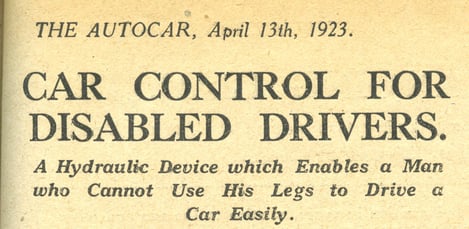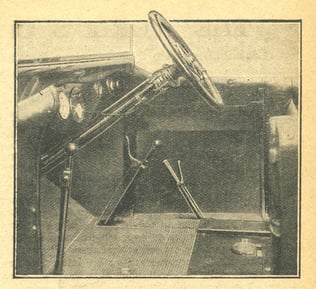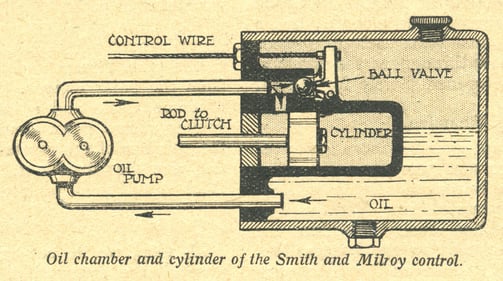November is Disability Awareness month, so we’ve been delving into the Archive collections to see what we could find about accessible driving or modified cars.
The document we’ve chosen as document of the month is an article from Autocar magazine which tells of a new device to enable a car to be driven using only the hands. You may be surprised to discover that this article dates from April 1923!
 In 1923, owning and driving a car was still something of a luxury. Although smaller cars, such as the Austin Seven, were entering the market and making motoring more affordable and attainable for the masses, in the early 1920s it was still much more exclusive than it is today. The Austin Seven and other “baby cars” like it, were also marketed to women as being smaller and therefore easier for them to drive, but at the time of this article the majority of drivers were still men.
In 1923, owning and driving a car was still something of a luxury. Although smaller cars, such as the Austin Seven, were entering the market and making motoring more affordable and attainable for the masses, in the early 1920s it was still much more exclusive than it is today. The Austin Seven and other “baby cars” like it, were also marketed to women as being smaller and therefore easier for them to drive, but at the time of this article the majority of drivers were still men.
Given the exclusivity of motoring in the 1920s, it may seem surprising that accessibility was considered. However, following the end of World War I in 1918, almost two million men returned home with some form of disability. This was double the number of men who lost their lives in the war, and equated to around 15% of the adult male population. Post-WWI, social attitudes to disability also began to change, and this paved the way for developments such as accessible or adapted motoring options.
Designed by Smith and Milroy Ltd. of Kent, the “new device” featured in the Autocar article consisted of several separate parts. A hydraulic mechanism, which used an oil reservoir and a piston, was connected to a trigger on the gear level of the car; when the trigger was pulled, it engaged the piston, which disengaged the clutch and enabled the gears to be changed. When the trigger was released, the clutch was re-engaged.
 There was also a lever attached to the steering column below the steering wheel, which controlled the throttle, and a hand brake in addition to the standard fitted handbrake. The hand brake had an additional clever function: when it was fully engaged, it would disconnect the clutch. This meant that starting the car from stationary was much more straightforward than it would have been if the driver had to operate the hand brake, gear stick and clutch trigger, and the throttle lever all at once.
There was also a lever attached to the steering column below the steering wheel, which controlled the throttle, and a hand brake in addition to the standard fitted handbrake. The hand brake had an additional clever function: when it was fully engaged, it would disconnect the clutch. This meant that starting the car from stationary was much more straightforward than it would have been if the driver had to operate the hand brake, gear stick and clutch trigger, and the throttle lever all at once.
 According to the article, there had been previous attempts to modify vehicles, but these adaptations had been makeshift and far from ideal. What set this new device apart was its effectiveness – the article asserts that “once accustomed to the new method of controlling the car, the movement of the levers and the driving of the car can be governed with the utmost delicacy”. The article does make it clear that the device isn’t cheap, due to “the number of parts required”, but that the device “should last as long as the car”.
According to the article, there had been previous attempts to modify vehicles, but these adaptations had been makeshift and far from ideal. What set this new device apart was its effectiveness – the article asserts that “once accustomed to the new method of controlling the car, the movement of the levers and the driving of the car can be governed with the utmost delicacy”. The article does make it clear that the device isn’t cheap, due to “the number of parts required”, but that the device “should last as long as the car”.
Of course, future developments would lead to vehicles designed specifically for disabled people, such as the Invacar, but devices like this one must have paved the way for accessible motoring.
You can see a copy of this article, alongside other documents relating to accessible vehicles and driving, in our Archive Display Cabinet in the Museum this month. Or to see them in more detail, you can book an appointment to consult the records in our Reading Room by emailing: history@britishmotormuseum.co.uk




















.png)


